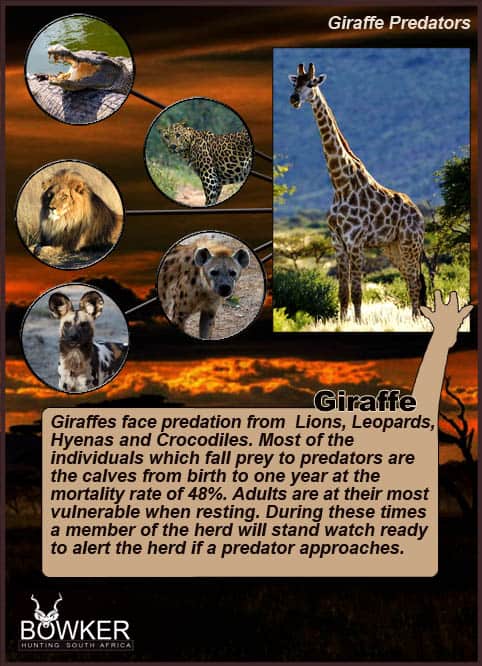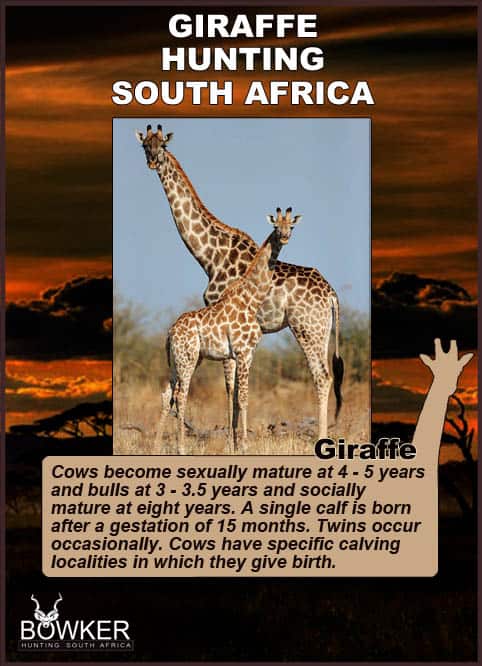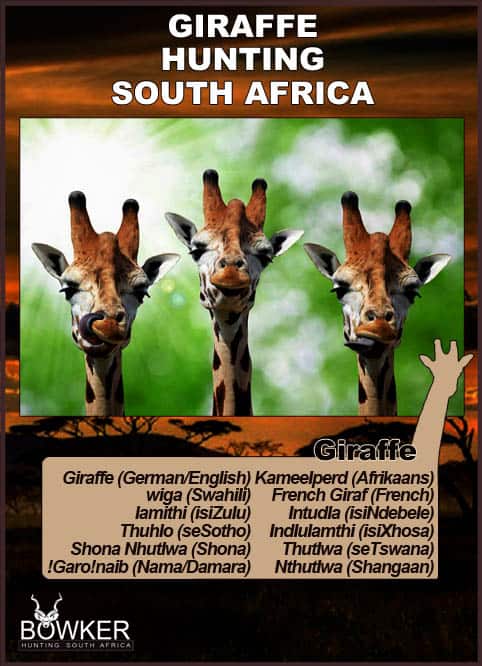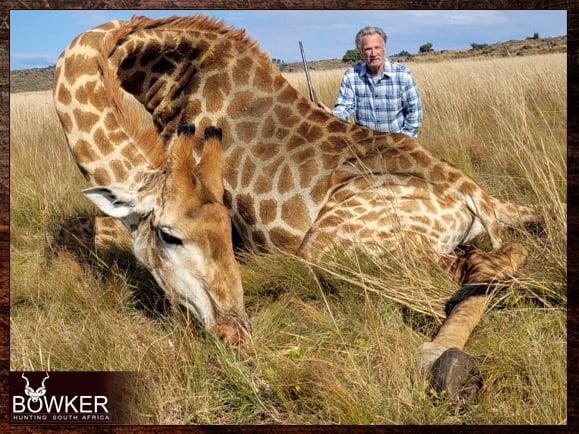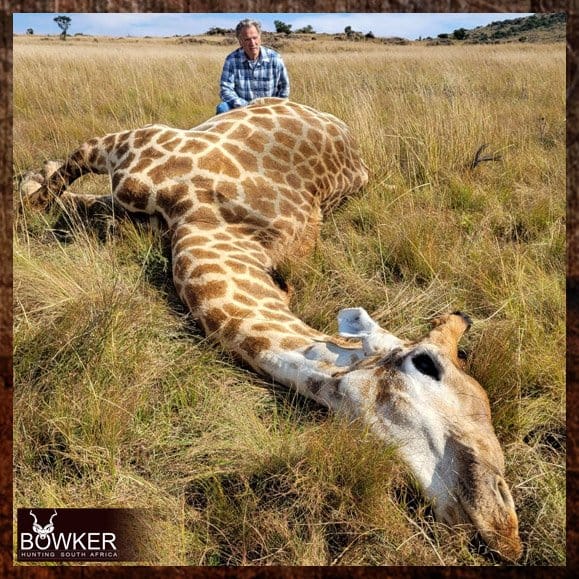
Summary
Giraffe Trophy hunting can make for a challenging and exciting stalk.
Hunting Giraffes is often done by spot and stalk or tracking his very distinctive spoor.
There are no seasonal restrictions on trophy Giraffes in Eastern Cape, South Africa.
Nick Bowker Hunting offers Giraffe Africa hunting trips year-round.
Giraffe hunts are typically in thick brush or savanna.
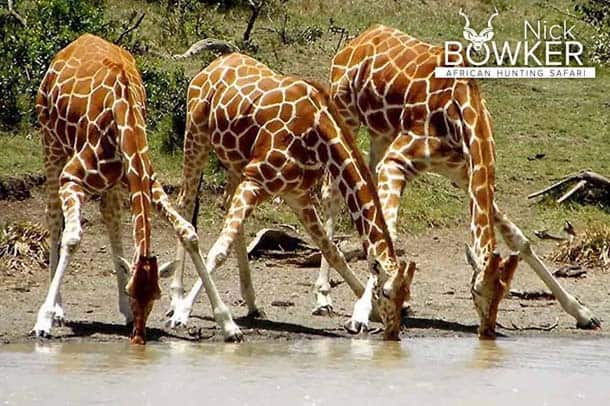
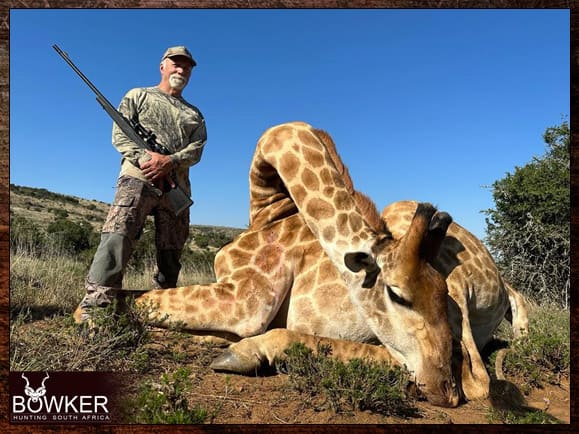
Table of Contents
Giraffe Trophy Fees in South Africa – 2025
The average price of a Giraffe trophy is around $3500. A giraffe can be added to any of our African hunting trip packages.
Our price for a Giraffe in 2025 is $4000.
The Giraffe trophy includes a licensed hunting guide, a hunting license, and all permits.
Hunting Giraffe in South Africa

Shot placement must be in the bottom third of the animal directly above the front shoulder. This will ensure a heart or lung shot. Avoid head and neck shots, which are high-risk.
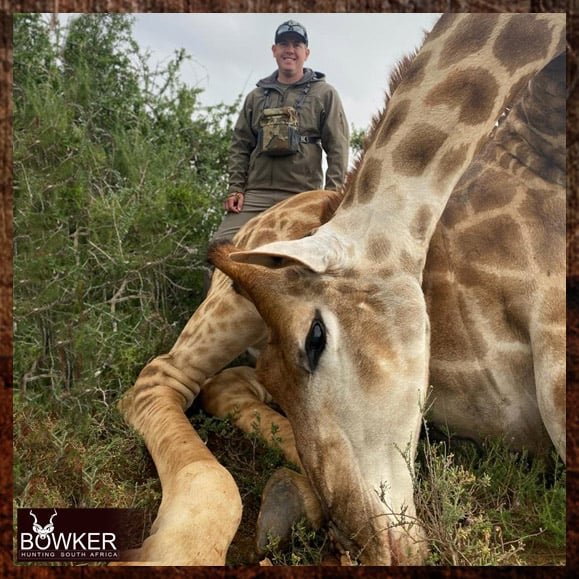
Your giraffe trophy should weigh about 2,500 pounds and be 8 feet tall.
This stately beast inhabits various plant habitats, from the dry woodlands to the reasonably dense low shrub veld.
But always present will be the thorn trees he feeds throughout the year.
A giraffe’s heart weighs approximately 25 pounds and is the biggest of any land mammal, and is used to pump 60 liters of blood around its body every minute at a blood pressure twice that of an average human.
The giraffe is not territorial and tends to avoid the very dense bush.
He feeds on a 6-foot band of browse, not accessible to all other animals except the elephant, with browsing being mainly during the day.
They can run as fast as 35 miles an hour over short distances or cruise at ten mph over longer distances.
Giraffe only needs to drink once every few days because most of their water comes from all the plants they eat.
Giraffe hunting can make for an extremely interesting and exciting stalk on a plains game hunt for the trophy hunter.
Trophy Judgement and Rifle Caliber for a Giraffe Hunt in Africa
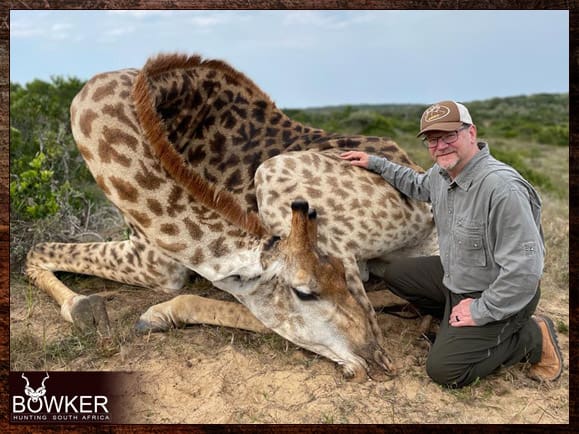
Hunting will most often be done by spot and stalk or tracking his very distinctive spoor.
Hunt Giraffe with a 375 in South Africa.
Nick Bowker has a 375 and ammunition for hunters not wishing to go through the red tape of bringing a rifle to South Africa.
Also, the rifle and ammunition are free of charge in your package.
The United States Fish and Wildlife Service may treat giraffes as endangered. This could result in a ban on importing taxidermy products.
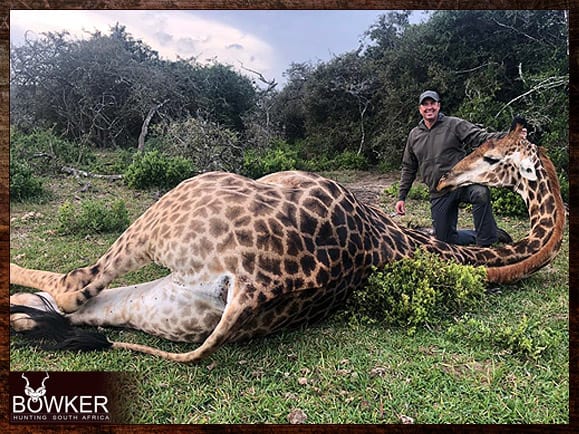
Any ban will achieve the exact opposite impact. Landowners will be forced to shoot out giraffe herds and replace the giraffe with domestic livestock.
A giraffe’s lungs are positioned well forward and high in the chest cavity. At the same time, the brain is tiny and set just below and between the horns.
If you make a spine shot, place it in the center of the neck, where the neck joins the body.
A quartering frontal shot should be aimed to break the prominent shoulder joint; avoid the quartering-away shot; take it only as a last resort! It’s an exciting addition to your game animals in the trophy room.
The Difference Between a Male and a Female for Giraffe Hunting
Males and females have a type of horn called ossicones, made of cartilage covered in skin. The Giraffe bull has larger ossicones used for fighting, causing the fur to rub off, exposing a bald spot on top of them. As a result, bulls will nearly always have these gray bald spots on the top of the ossicones.
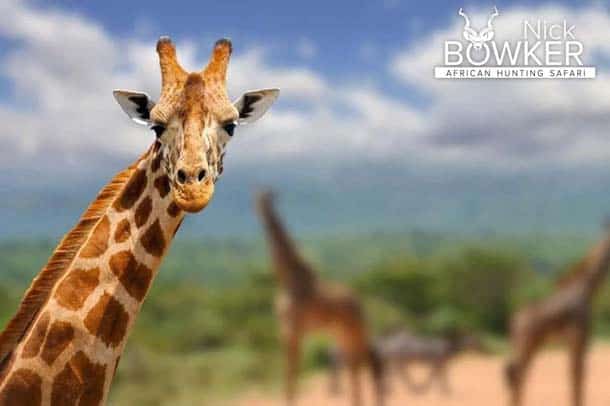

Interesting facts about the Giraffe for hunters

- The giraffe species is the tallest mammal in the world, with their legs alone being more elevated than many humans, about 6 feet.
- A giraffe’s neck is too short to reach the ground. As a result, it has to spread its front legs or kneel to reach the ground to drink water.
- Giraffe spends most of their lives standing up; they even sleep and give birth standing up.
- Giraffe young can stand up and walk after an hour, and within a week, it starts to eat some vegetation.
- Calves are often killed in their first few months, although the females attempt to stand over their calves during attacks by lions, spotted hyenas, leopards, and African wild dogs.
- A giraffe species’ spots are much like human fingerprints. As a result, no two individual giraffes have the same pattern.
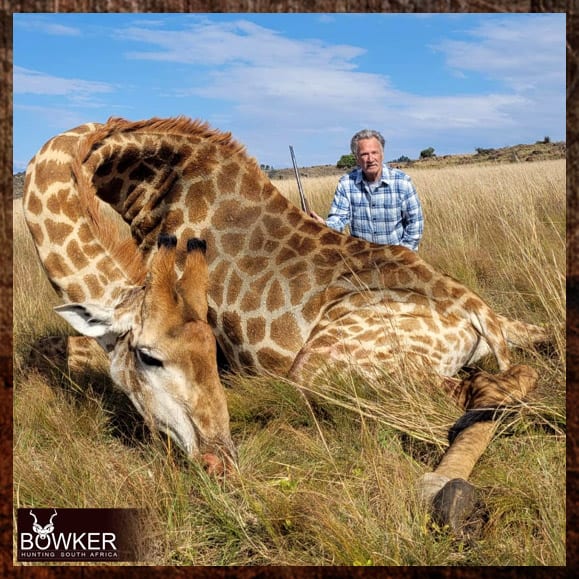
- Giraffe only needs 5 to 30 minutes of sleep in 24 hours. Achieved in quick naps that can last only a minute.
- It was thought that giraffes do not make any sound. But this is untrue, as giraffe makes low-pitched noises beyond the range of human hearing.
- To protect the giraffe’s brain from sudden changes in blood pressure when it lowers its head to drink, it has valves to stop the backflow of blood.
- A female giraffe gives birth standing up. As a result, their young fall about 2m to the ground and can stand up within an hour of birth. The newborn giraffe is taller than most humans.
- Giraffes are plentiful and available throughout much of South Africa and are not considered endangered. Giraffe hunting takes place throughout South Africa.
About the Giraffe for Hunts
Description for the hunter

Giraffes usually inhabit savannahs and open woodlands. Also, they feed on shrubs, grass, and fruit and eat around 75 pounds of foliage daily.
Fully grown giraffes stand 14.1 – 18.7 feet tall, with males taller than females.
The tallest recorded male was 19.3 feet, and the tallest recorded female was 17 feet tall.
The average weight is 2,628 pounds for an adult male and 1,825 pounds for an adult female. Despite its long neck and legs, the giraffe’s body is short in comparison.
Located at both sides of the head, the giraffe’s large, bulging eyes give it an excellent all-around vision from its great height.
A Giraffe has a perfect sense of hearing and smell and can close its muscular nostrils to protect against sandstorms and ants.
Giraffe hunting, while unusual, is well worthwhile. They have good eyesight.
Male giraffes become darker as they age.
Hunting Information
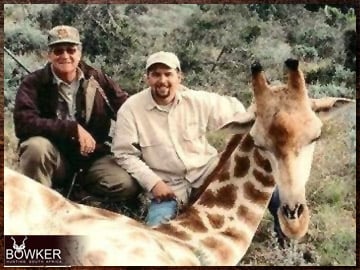
The giraffe’s prehensile tongue is about 18 inches long. for getting at the most challenging foliage. Also, the tongue is purplish-black, perhaps to protect against sunburn, and helps grasp foliage, as well as for grooming and cleaning the animal’s nose.
The giraffe’s upper lip is also prehensile and useful for foraging and covered in hair to protect against thorns.
Also, the tongue and inside of the mouth have papillae.
The coat has dark patches, which can be orange, chestnut, brown, or nearly black, separated by light hair, usually white or cream.
The skin color and pattern serve as camouflage in the light and shade patterns of savannah woodlands.
Giraffe calves inherit pattern traits from their mothers.
The skin underneath the dark areas helps with thermoregulation.
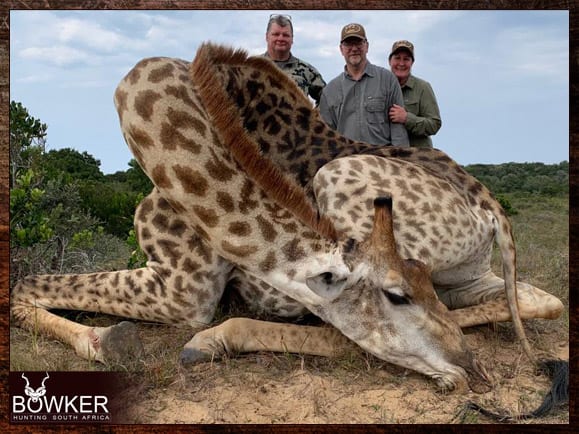
Frequently Asked Questions About Hunts for a Giraffe Trophy
How much does it cost to hunt a Giraffe in South Africa?
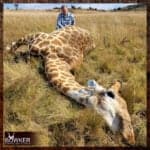
Trophy fees as a standalone Giraffe hunt are between $3,000 – $4,000. Daily rates vary between $250 and $500 per day.
Included in the Giraffe trophy fee is a licensed guide. As well as a hunting license and all permits.
How to hunt giraffes in South Africa?

Giraffes are hunted by spot and stalk or tracking their very distinctive spoor.
Where do you shoot a Giraffe?

Shot placement must be in the bottom third of the animal directly above the front shoulder. This will ensure a heart or lung shot. Avoid head and neck shots, which are high-risk.
When can you hunt Giraffe in South Africa?
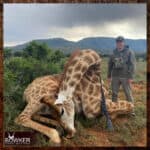
There are no seasonal restrictions on trophy Giraffe hunting in the Eastern Cape of South Africa.
What Caliber is Recommended for Giraffe Hunts?

Hunt Giraffe with a 375 in South Africa.
Giraffe in Pictures

